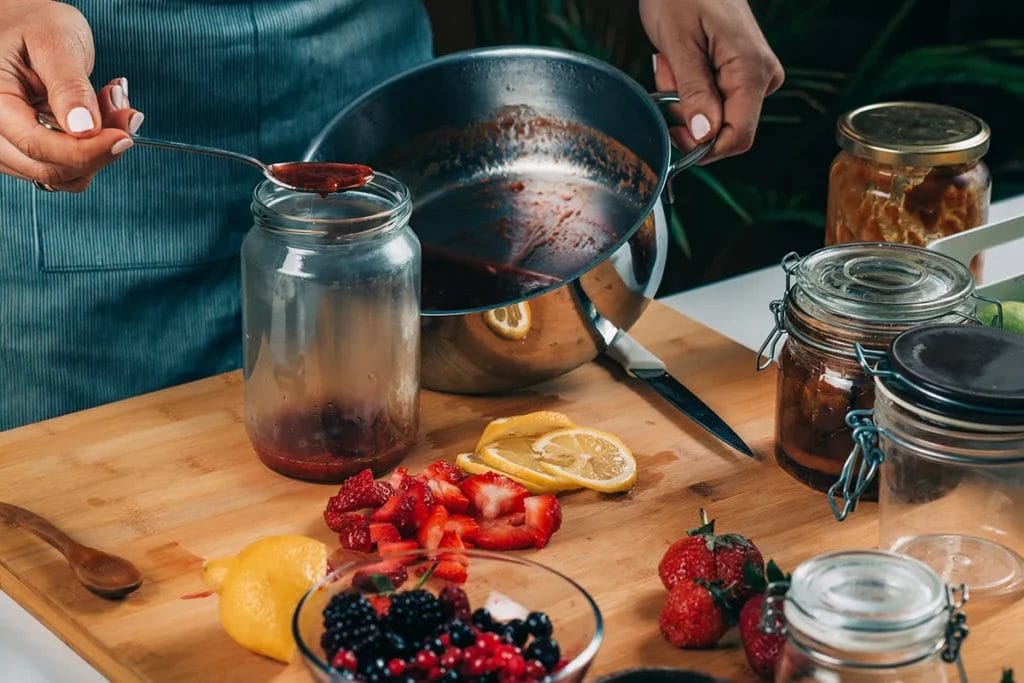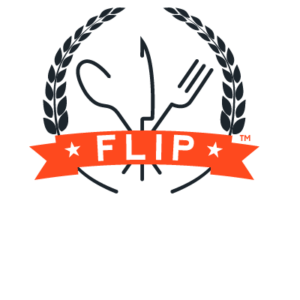Last Updated: November 15, 2024 by Alex Hastings
Starting a food business from home is the ultimate WFH (work from home) solution for anyone who wants to make a living off their culinary skills.
To help you get started, we’ve compiled the top 10 things you need to keep in mind when building your new home food business. Make sure you tick all the boxes on our list and set yourself up for success!

1. Comply With Your State’s Cottage Food Laws
Did you know that each state has rules regulating the sale of homemade foods? They’re called cottage food laws. They dictate things like which foods you are legally allowed to sell from home, whether there is an annual sales limit, and how you must label your products.
These laws differ from one state to the next — some states have stricter laws than others. If you live in a state with more restrictions, running a home-based food business as a side hustle might be easier than relying on it as your sole source of income.
For example, Wyoming puts very few restrictions on homemade food sales. It allows the widest variety of foods to be sold and only caps sales at $250,000. However, Delaware has an extensive application process and an annual sales limit of $25,000.
To learn more about the cottage food laws that will affect your business, go to your state’s Department of Agriculture website for a complete list of regulations.
2. Get to Know Your Market
Competitive Research
Scope out the competitors in your space and get to know them well with these questions:
- What products/services do they offer?
- How are they pricing their products/services?
- How do they brand themselves?
- What are customers saying about them?
- How are they promoting their business?
- What makes them different from other businesses in this space?
By getting to know your competition, you can learn from their successes and failures and identify ways to set your business apart from theirs.
Customer Research
Your target market will affect everything about your business, from your pricing strategy to your promotional efforts.
You should know the following information about your target customers:
- Demographics: This includes things like age range, income, location, and lifestyle.
- Purchasing behavior: This might include whether they are price-sensitive, if buying from local businesses is important to them, or how frequently they would buy your product or invest in your service.
- Pain points and desires: Identify what your customers’ motivations are and what problems of theirs your business would solve.

3. Acquire the Licenses and Permits Needed to Sell Food From Home
Starting a home-based food business does involve a bit of paperwork. But it’s completely manageable once you know which permits and licenses you need to acquire.
As with most legal requirements, this list may vary depending on where you live or what kind of business you’re starting. The requirements for a home-based bakery might differ slightly vs. those required for a caterer, for example.
However, most businesses will need some combination of the following.
Cottage Food License
Business License
Doing Business As (DBA)
Home Occupation Permit
Beneficial Ownership Information (BOI)
Food Handler’s Permit
Health Department Permit
Fire Department Permit
Sales Tax Permit
4. Purchase High-Quality Kitchen Equipment
Turning your culinary passion into a home business means upgrading your gear! The volume of food you produce is about to increase and you’ll need equipment that can handle that level of production.
The equipment you need will vary a bit depending on the type of business you run or the kind of foods/beverages you make. However, you can count on needing most of the items listed below.
Kitchen Appliances
- Oven and/or stovetop (possibly commercial-grade)
- Refrigerator and freezer (possibly commercial-grade)
- Microwave
- Food processor
- Stand mixer
- Dishwasher
Food Prep Essentials
- High-quality knives
- Cutting boards
- Measuring cups/spoons
- Spatulas
- Whisks
- Tongs
- Mixing bowls
- Baking sheets/trays
- Timers
- Thermometers
Storage
- Food-safe containers with airtight lids
- Storage racks
- Shelving units
Packaging
- Vacuum sealer
- Boxes/bags
- Tamper-evident seals
- Sealable food containers
- Labels/label printer (especially if your state has specific labeling requirements)
Sanitization and Safety
- Sanitizing wipes
- Food-safe disinfectant sprays
- Dish soap
- Designated handwashing station (required in some states)
- Fire extinguisher
- First aid kit
- Personal Protective Equipment (PPE)
If your state won’t allow you to sell food from your residential kitchen or yours doesn’t meet some of their requirements, consider renting a commercial kitchen instead! They offer commercial-grade appliances and give you more space to handle higher volumes of food production.

5. Develop a Financial Plan
It’s no secret that starting a business costs money, which is why you should start financially planning as soon as possible. A good plan will help you avoid overspending and can keep you on track to meet your financial goals.
To begin, calculate your startup costs by adding up the cost of things like:
- Kitchen equipment and supplies
- Licenses and permits
- Ingredients
- Packaging supplies
- Cleaning supplies
- Home-based food business insurance
- Utilities
- Taxes
- Accounting and inventory software
- Marketing (includes the cost of a website, printing business cards, promoting social media posts, etc.)
- Commercial kitchen rent (if applicable)
After identifying how much it will cost you to start your new business, determine how you will fund it:
- Personal savings: Starting a food business with your own money is ideal because you won’t accrue any debt or owe interest. However, many people can’t finance their new business on personal savings alone.
- Help from friends and loved ones: If people want to invest in or loan you money for your new business, great! Just make sure you have the terms of that investment written down in a legal contract to avoid future conflicts.
- Small Business Association (SBA) loans: The SBA offers financial assistance to small businesses, including microloans (up to $50,000) with structured repayment plans.
- Bank loans: Bank or credit union loans provide access to larger amounts of money but usually require a good credit score and may require you to put up collateral.
- Grants: These are highly competitive and difficult to obtain, but you never have to worry about repayment! The SBA sometimes offers grants, as do state and local governments.
- Crowdfunding: You can use sites like Indiegogo and Kickstarter to get help from generous public donors to start your business in exchange for rewards or special offerings.
6. Set Your Prices
Many first-time business owners make the mistake of basing their prices solely on what their competitors are charging, but that’s a recipe for disaster.
Your competitors may have completely different expenses than you or be aiming for a different profit margin.
Pricing your products will involve a little math, but it’s not rocket science.
Determine Your Input Costs
Ingredients
Labor
Overhead
Your overhead costs include both fixed (e.g., rent, permits, insurance, and so on) and variable expenses. Variable costs can change from one month to the next, like the number of labels you had to print because you got an influx of orders in July compared to August.
For that reason, you have to do a little estimating when it comes to your overhead.
To calculate the overhead cost per item, determine roughly how many products or services you expect to sell each month. Don’t overestimate — lean towards a conservative number at first.
Then, divide your estimated overhead costs by your estimated number of goods/products sold.
Calculate Your Cost of Goods Sold
Cost of Ingredients + Cost of Labor + Overhead Costs = Cost of Goods Sold
Choose a Pricing Strategy to Set Your Markup
Of course, you can’t just sell your products or services at the COGS! Your final price will also include your desired markup as well to ensure you’re making a profit.
Check out some of the most popular pricing strategies food businesses use and find the right one for you!

7. Build an Awesome Brand
Whether you want to start a home-based baking business or sell pre-made meals out of your kitchen, branding your business is key to its success. Branding gives your business an identity and is yet another way that you can set your business apart from the competition.
Your Core Values and Mission
Why did you start a food business from home?
Did you grow up cooking with a loved one and have always harbored a dream to share their recipes with the community? Did you start a meal kit company because you want to help people reach their nutritional goals despite their busy schedules?
Your core values and mission are a huge part of what makes your business unique, so don’t leave them behind when it comes to branding!
Your Business Name
A strong business name does all of the following:
- Reflects your business’ core values and aligns with your mission
- Sets you apart from the competition by not being too similar to other businesses in your area
- Incorporates search-friendly words that make it easy to find on search engines
Need more ideas? Explore our personal chef business names and name ideas for your cake business! They’re chock-full of strategies you can use to brainstorm name ideas and help you find the one that best matches your brand.
Your Logo and Colors
A great logo sticks in your mind forever — think of the McDonald’s golden arches or the Nike swoosh. In fact, it only takes roughly 10 seconds for customers to form an impression of a brand from its logo!
No matter what kind of business you’re running, a successful logo is:
- Simple: Complex designs are hard to remember and harder to scale as you use your logo in different sizes across your website, packing, and more.
- Unique: Your logo shouldn’t look too much like any of your competitors. You want customers to recognize yours as belonging to you!
- Timeless: It might be tempting to follow certain graphic design trends, but think of how trendy logos of yesteryear look dated today. Have a little fun, but opt for something classic that won’t need a revamp in 3 years.
Hiring a graphic designer is the best way to get a professional logo that ticks all of these boxes, but a budget-friendly option is to make one yourself in Canva.
Your business’ colors will play a big role in your logo, as well as all of your branding, so put careful thought into what you choose!
8. Create Your Website
Your website is the hub of all things related to your business, so it’s crucial to have one that is both beautiful and functional.
Hiring an agency to build your site will probably come with a price tag in the thousands. However, you can hire a freelance professional web designer on a site like Fiverr to build your site starting under $100.
Today’s artificial intelligence (AI) site builders also make it easy if you’re up for building it yourself. If you do opt to go the DIY route, Wix, GoDaddy, and Hostinger are great options complete with templates and AI assistance.
Regardless of who builds your site, make sure it has these qualities:
- Easy to navigate: Your website should have a clear menu that allows any visitors to find their way around without scratching their heads.
- Search Engine Optimization (SEO): A good website is easy to find on Google because it contains search-friendly keywords that your customers are actually searching for. Use a keyword tool to find terms that relate to your business.
- Helpful, up-to-date information: Be sure to include your contact info, social media handles, a short bio, high-quality images, and your menu or services.
- Mobile-friendly version: Your website should look good on desktop computers, mobile phones, and tablets so that customers can easily access it from any device.
- Consistent branding: Incorporate your logo and brand colors tastefully throughout your site.

9. Promote Your Business With a Solid Marketing Strategy
Social Media Marketing
You want to reach customers where they are. When the average American spends 2 hours and 14 minutes on social media per day, that’s where your business needs to be.
Food businesses benefit the most from platforms that are highly visual and allow users to share and view images and videos. Reel them in with delicious shots of your menu items!
The best platforms for home-based food businesses are:
All of the above offer great paid advertising opportunities where you can turn any post into an ad. Try promoting a post so that it shows up in the feed of people who aren’t following you but might be interested in what you’re selling.
Discover how you can use Instagram to your marketing advantage and start building a following!
Traditional Marketing Collateral
It might seem outdated to use traditional marketing materials to promote your business in this increasingly digital age, but there’s a reason businesses haven’t moved away from it entirely.
Using these forms of traditional marketing can be effective in attracting new customers while keeping your marketing strategy balanced.
Stickers
Whether you include them as freebies with a purchase or sell them as merch, people love buying stickers to show their support for a business. Plus, they’re pretty cheap to produce on sites like StickerYou.
Business Cards
Flyers
Word-of-Mouth
You’ve probably followed a recommendation from a friend or loved one before, whether that was for a movie, vacation spot, or restaurant.
So, it probably won’t come as a surprise to learn that word-of-mouth marketing is responsible for 90% of all purchases.
Here are a few ways you can get people buzzing about your business.
Create a Referral Program
Ask for Reviews
Send follow-up emails after a purchase asking kindly if your customers would leave a review on Google or Yelp if they were happy with their purchase. You can then display positive testimonials on your website, which has been shown to boost revenue by 270%!
Offer Outstanding Customer Service
When customers can tell that you genuinely care about their experience or went above and beyond to help them, their impression of your business will be a positive one. That good impression increases the likelihood that they will tell their friends and loved ones about you, potentially earning you new customers.
If you’re starting a home bakery and are hungry for more tips, check out our list of marketing strategies for home-based bakers!
10. Protect Your Home-Based Food Business With Insurance
Do you still need insurance if you’re running your food business from home?
Yes!
All businesses, regardless of where they’re located, need liability insurance because they all face risks.
For your home food business, those risks could look like:
- A customer slipping on the icy staircase leading up to your home as they arrive to pick up an order and suing you for their injuries
- One of your customers eats some of your chocolate chip cookies, has an allergic reaction because they contain nuts, and sues you over their medical costs
- You accidentally cause a grease fire at the commercial kitchen you rent and they hold you responsible to pay for repairs
These incidents are all scary to think about, but when your business is insured you worry less knowing you have coverage in place if something goes awry.
Learn more about how you can protect your business with home food business insurance and get a free quote in 10 minutes or less through our online app!

FAQs About Starting a Food Business From Home
Pickled goods have a high profit margin of 50% and it can cost as little as $1,000 to start your business, making them the most lucrative option.
If you’re looking for a side hustle, start a meal prep service. It’s a flexible business you can manage shopping and cooking for on your weekends or after your day job. Because most of these businesses operate on a subscription model, it’s easy for you to know what to prepare for each month.
Teaching cooking classes is the least risky food business venture, especially if you teach online. While things can still go wrong, like a student burning themselves on a stove during your class, you don’t have to worry as much about common claims like food poisoning.
A good home-based food business plan will have the following sections:
- Executive summary: A quick, exciting overview of your business.
- Company description: A more in-depth look at your business, including what your long-term goals are.
- Market analysis: An examination of your competitors, customers, and the market in which your business operates.
- Loans and financing: An explanation of how you are financing your business, including how much money you still need to obtain, where you plan to get it, and how you will spend it.
- Operation costs and financial projections: A detailed summary of your expenses and revenue (current and projected).
- Certificate of Insurance (COI): Proof that your business is properly insured and protected against common liability risks.

Updated by Alex Hastings
Alex is a Marketing Copywriter at Food Liability Insurance Program (FLIP). In her free time, she enjoys reading, birding, traveling, and finding any excuse to get brunch.

Reviewed by: Kyle Jude
Kyle Jude is the Program Manager for Food Liability Insurance Program (FLIP). As a dedicated program manager with 10+ years of experience in the insurance industry, Kyle offers insight into different coverages for food and beverage business professionals who are looking to navigate business liability insurance.


